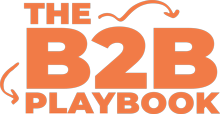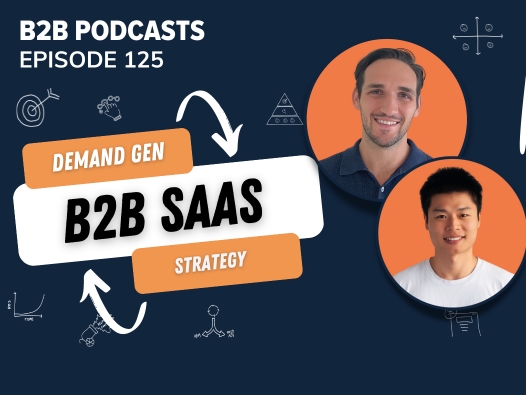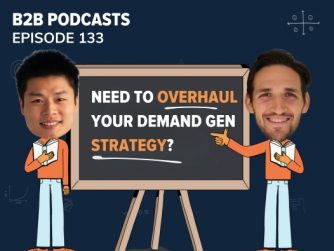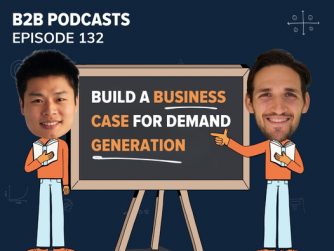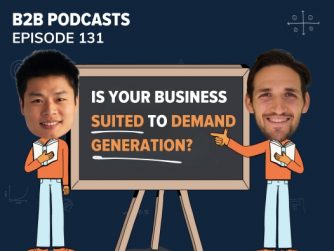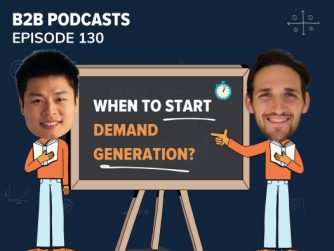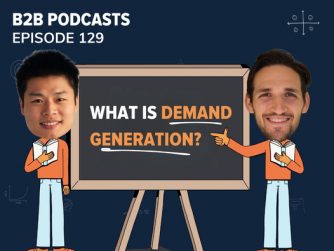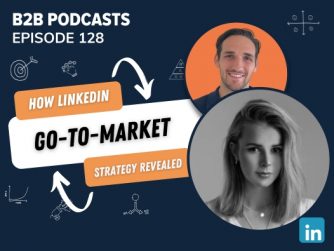How can B2B SaaS companies implement a demand generation framework that drives consistent pipeline? This is just one of the questions that Factors.ai asked me in our live event last month.
My answer (perhaps much to the delight and disappointment of our hardcore fans) – our 5 BEs Framework for Demand Generation.
Sorry folks, there’s no silver bullet. If you want to drive consistent pipeline and revenue for your business, you need to put the hard work in and follow our set process.
Factors.ai had us on their show to detail this process – so make sure you watch, listen to or read the key insights below.
Listen To The Episode
Watch The Episode
What Is Our Definition of Demand Generation?
Demand Generation is a go-to-market strategy that builds an intense desire in your Dream Customer to purchase from you. It’s comprised of two key components: demand creation, and demand capture.
Demand capture is the approach that most B2B SaaS businesses will take. This is targeting the 3% of the market that is ready to buy right now. The reason many SaaS businesses fail to scale beyond their initial points of traction is because they only ever look to this 3% of the market, and dedicate all their resources to it.
As you try to take more of this 3% for yourself, the competition becomes fiercer as you’re all trying to take a bigger slice of the same sized pie. Inevitably your cost per acquisition blows out, and the business is left scrambling to find their next growth levers. Typical demand capture activities include running Google Ads targeting high intent keywords, or bidding on searches on review platforms like G2.
Demand creation, on the other hand, targets the larger portion of the market (97%) that is not in immediate buy mode. This process involves building relationships, earning trust, and guiding potential customers to recognize that your product or service is the best solution for your customer’s problem. This strategic element is crucial for broadening the market beyond those immediately ready to purchase.
Advice For SaaS Businesses Setting Up Their Demand Gen Motion
There’s three key pieces of advice I offer to SaaS businesses looking to setup their demand gen motion.
They are:
- Develop a Documented Plan: They key is to avoid random acts of marketing and focus on a structured, stage-by-stage approach to demand creation (our 5 BEs Framework)
- Allocate Resources Wisely: Initially, dedicate 10 to 20% of your time and budget to executing your demand creation plan. The business might still require the majority of your efforts elsewhere, but gradually, more resources should be shifted to demand creation
- Execute a Pilot and Scale: Start with the plan, execute a pilot to test its effectiveness, and then present the successful results to leadership to secure more resources for scaling.
You need a thoughtful and measured approach to building demand generation for SaaS businesses. So often random acts of marketing are disguised as ‘growth hacking’. Experimentation is an important part of marketing, but it absolutely should not replace fundamental strategy work.
The more our strategy is informed by insights from the customer, the less ‘testing and learning’ we’ll have to do!
How Do We Generate Demand For The B2B Playbook?
When it comes to demand generation for The B2B Playbook, we “eat our own dog food” so to speak. We practice exactly what we preach, and our business is completely driven by our demand generation approach (our 5 BEs Framework). Here’s a breakdown of how our strategy ties together:
- Deep Customer Understanding: We deeply understand our target audience – B2B marketers in small teams who need to start contributing to pipeline. This understanding is achieved through regular engagement and conversations with our audience, especially those who have come through our Demand Gen program The B2B Incubator or have interacted with our content. This allows us to tailor our content and solutions more effectively to the needs of their audience.
- Content Creation and Distribution: Central to our demand generation strategy is the creation of valuable, ungated content that helps their audience overcome challenges and perform their jobs more efficiently. The content also maps the buying journey, answering questions and ushering a potential buyer towards purchase at each stage. Our favourite content framework for doing this is called the 5 Stages of Awareness. This content is distributed primarily through LinkedIn, which serves as our most significant distribution channel. By providing helpful and accessible content, we’re building trust and establishing our brand as a valuable resource in the B2B marketing space.
- Account-Based Marketing (ABM): We use ABM to accelerate demand and target companies that show interest in our offerings. Sources we’ll use to qualify companies for ABM include: the behaviour of key contacts on our website, the use of website identification software to see who is browsing it, their interaction with any assets of ours (like LinkedIn Ads or organic LinkedIn). This targeted approach allows us to develop deeper relationships with potential clients, tailored to the specific needs and interests of each account.
- Building Relationships: For higher value clients, a key part of our strategy involves inviting key decision-makers and influencers from interested companies onto their podcast. This not only helps deepen relationships with potential clients by understanding their challenges better but also provides a platform to showcase their expertise and the value of their solutions.
- Measuring Success and Scaling: George mentions the importance of starting with a plan, executing a pilot, and measuring its success. Once they prove the effectiveness of their demand generation activities, they advocate for scaling these efforts by allocating more time and resources, based on the evidence of success. We have a detailed guide on demand gen metrics and KPIs to measure here.
These are the fundamental principles that should underpin any B2B SaaS demand generation strategy. If you’d like more detail on each of these 5 stages, please make sure you check out our 5 BEs Framework for demand generation marketing.
We share it every week on our podcast, The B2B Playbook. Check it out here.
